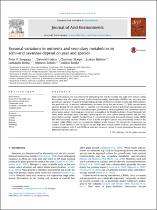 ResearchSpace
ResearchSpace
Seasonal variations in nutrients and secondary metabolites in semi-arid savannas depend on year and species
JavaScript is disabled for your browser. Some features of this site may not work without it.
- ResearchSpace
- →
- Research Publications/Outputs
- →
- Journal Articles
- →
- View Item
| dc.contributor.author |
Scogings, PF

|
|
| dc.contributor.author |
Hattas, D

|
|
| dc.contributor.author |
Skarpe, C

|
|
| dc.contributor.author |
Hjältén, J

|
|
| dc.contributor.author |
Dziba, L

|
|
| dc.contributor.author |
Zobolo, A

|
|
| dc.contributor.author |
Rooke, T

|
|
| dc.date.accessioned | 2015-05-25T10:52:14Z | |
| dc.date.available | 2015-05-25T10:52:14Z | |
| dc.date.issued | 2015-03 | |
| dc.identifier.citation | Scogings, PF, Hattas, D,Skarpe, C,Hjältén, J, Dziba, L, Zobolo, A, and Rooke, T.2015. Seasonal variations in nutrients and secondary metabolites in semi-arid savannas depend on year and species. Journal of Arid Environments, vol. 114 (2015), pp 54-61 | en_US |
| dc.identifier.issn | 0140-1963 | |
| dc.identifier.uri | http://hdl.handle.net/10204/7976 | |
| dc.description | Copyright: 2015 Elsevier. | en_US |
| dc.description.abstract | Semi-arid savannas are characterised by alternating wet and dry seasons and large inter-annual rainfall fluctuations that affect plant growth. Carbon-based secondary metabolites (CBSMs) vary inversely with growth and nutrients because of the physiological trade-off between cellular growth and differentiation. We predicted that (1) nutrient concentrations decrease during the wet season, (2) CBSM concentrations increase during the wet season and (3) nutrient concentrations are lowest and CBSM concentrations are highest in the dry season. We measured nitrogen, phosphorus, total polyphenols and condensed tannins in six woody species (including one evergreen) seasonally at the Nkuhlu exclosure, Kruger National Park, South Africa, for three consecutive years, including one ‘wet’ year (above-average rainfall) and two ‘dry’ years (below-average rainfall). Neither N nor P consistently decreased during wet seasons, while CBSMs did not consistently increase. Neither N nor P in the evergreen species was consistently lowest in dry seasons, while CBSMs were not consistently highest in dry seasons. We discuss the inconsistent responses in the context of species-specificity and high inter-annual rainfall variation. We conclude that seasonal variations in N, P and CBSMs in semi-arid savannas cannot be easily generalised because they depend on species and year | en_US |
| dc.language.iso | en | en_US |
| dc.publisher | Elsevier | en_US |
| dc.relation.ispartofseries | Workflow;13933 | |
| dc.subject | Semi-arid savannas | en_US |
| dc.subject | Carbon-based secondary metabolites | en_US |
| dc.subject | Herbivore | en_US |
| dc.subject | Phenology | en_US |
| dc.subject | Woody | en_US |
| dc.subject | Plant growth | en_US |
| dc.title | Seasonal variations in nutrients and secondary metabolites in semi-arid savannas depend on year and species | en_US |
| dc.type | Article | en_US |
| dc.identifier.apacitation | Scogings, P., Hattas, D., Skarpe, C., Hjältén, J., Dziba, L., Zobolo, A., & Rooke, T. (2015). Seasonal variations in nutrients and secondary metabolites in semi-arid savannas depend on year and species. http://hdl.handle.net/10204/7976 | en_ZA |
| dc.identifier.chicagocitation | Scogings, PF, D Hattas, C Skarpe, J Hjältén, L Dziba, A Zobolo, and T Rooke "Seasonal variations in nutrients and secondary metabolites in semi-arid savannas depend on year and species." (2015) http://hdl.handle.net/10204/7976 | en_ZA |
| dc.identifier.vancouvercitation | Scogings P, Hattas D, Skarpe C, Hjältén J, Dziba L, Zobolo A, et al. Seasonal variations in nutrients and secondary metabolites in semi-arid savannas depend on year and species. 2015; http://hdl.handle.net/10204/7976. | en_ZA |
| dc.identifier.ris | TY - Article AU - Scogings, PF AU - Hattas, D AU - Skarpe, C AU - Hjältén, J AU - Dziba, L AU - Zobolo, A AU - Rooke, T AB - Semi-arid savannas are characterised by alternating wet and dry seasons and large inter-annual rainfall fluctuations that affect plant growth. Carbon-based secondary metabolites (CBSMs) vary inversely with growth and nutrients because of the physiological trade-off between cellular growth and differentiation. We predicted that (1) nutrient concentrations decrease during the wet season, (2) CBSM concentrations increase during the wet season and (3) nutrient concentrations are lowest and CBSM concentrations are highest in the dry season. We measured nitrogen, phosphorus, total polyphenols and condensed tannins in six woody species (including one evergreen) seasonally at the Nkuhlu exclosure, Kruger National Park, South Africa, for three consecutive years, including one ‘wet’ year (above-average rainfall) and two ‘dry’ years (below-average rainfall). Neither N nor P consistently decreased during wet seasons, while CBSMs did not consistently increase. Neither N nor P in the evergreen species was consistently lowest in dry seasons, while CBSMs were not consistently highest in dry seasons. We discuss the inconsistent responses in the context of species-specificity and high inter-annual rainfall variation. We conclude that seasonal variations in N, P and CBSMs in semi-arid savannas cannot be easily generalised because they depend on species and year DA - 2015-03 DB - ResearchSpace DP - CSIR KW - Semi-arid savannas KW - Carbon-based secondary metabolites KW - Herbivore KW - Phenology KW - Woody KW - Plant growth LK - https://researchspace.csir.co.za PY - 2015 SM - 0140-1963 T1 - Seasonal variations in nutrients and secondary metabolites in semi-arid savannas depend on year and species TI - Seasonal variations in nutrients and secondary metabolites in semi-arid savannas depend on year and species UR - http://hdl.handle.net/10204/7976 ER - | en_ZA |





